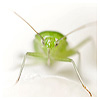Extreme Macro Tips
by Johan J Ingles-Le Nobel
Last updated August 31, 2017
Extreme macro is great for bringing out the detail in the very small. Use this collection of top 20 extreme macro tips to help you make the most out of your extreme macro adventures, lessons I've learned the hard way but which are hopefully of some use to you too!
The tips here will hopefully only grow and grow, so do check back periodically as I find time to post any new tips that you, the reader, might want to share with others using the commenting feature on the site.
Horizontal flash setup for extreme macro. Rather than having the flash sit on an arm fixed to the camera, I opted to lean the flash over the subject. This setup uses adjustable shoe mounts and PC-sync with manual flash mode, although nowadays I use a Nissin SC-01 universal off camera shoe cord to allow the use of rear curtain sync.
The horizontal setup works well because the flash is very near the subject so you need to use far less battery power, which means longer lasting batteries and much faster flash recharge times.
Composition
It would be utterly ridiculous for me to foist my composition preferences on anyone else. Composition is largely a personal thing and there is no right or wrong, really. Having said that, in terms of noticing which images are successful with many people and which are not, there are a few points worth observing. Simplicity is good; the world is not short of overfussy macro shots in which the subject is not clear. Be sensible: get to know the habits of the insects you want to photograph and don't be above making yourself composition aids to make things easier.
Look and Learn
I spend far more time looking at superb images than making them myself. This is not to copy or plagiarise, but if you don't take the time to study and works out what works to make certain images especially good, then you have little hope of doing the same. The magic touch of talent is usually accompanied by a great deal of figuring out what to do in the first place - good shots are not usually accidents or by coincidence. Flickr is full of very good extreme macro photographers and there are superb groups devoted to the subject. There are some classic authors and books every photographer and macro photographer should buy, and some superb photomacrography forums out there with knowledge and expertise that make me seem like a nursery book.
The Shooting Angle
It's so very easy to shoot down onto that bug on a leaf and 90% of macro shots do this. But, there are better and more interesting angles: try looking up to make it look impressive, from the side to almost silhouette the shape or a more traditional 3/4 view to add some personality. There's no right or wrong but they work for me.
Equipment
Everyone loves their brand of camera, but if you're starting out brand new, Canon really is the obvious brand to choose for extreme macro. If you're a bit of a Pentaxian like myself then rid yourself of your bellows orientation issues with this bellows tip, and for all brands and makes: make your life easier with a flash and diffusion setup that gets close to the subject thus letting you machine-gun away.
Technical Tips
Little technical things can and do make a difference in macro. Knowing how to slab, using those histograms and doing absolutely everything for detail will make your extreme macro better. Once you reach the rank of Ninja retoucher the world is your oyster!
Related Articles





